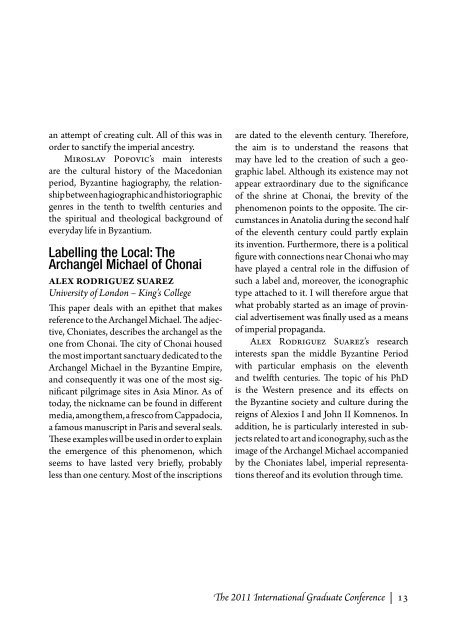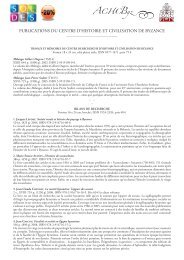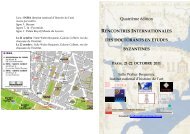an attempt <strong>of</strong> creating cult. All <strong>of</strong> this was inorder to sanctify the imperial ancestry.Miroslav Popovic’s main interestsare the cultural history <strong>of</strong> the Macedonianperiod, <strong>Byzantine</strong> hagiography, the relationshipbetween hagiographic and historio graphicgenres in the tenth to twelfth centuries andthe spiritual and theological background <strong>of</strong>everyday life in Byzantium.Labelling the Local: TheArchangel Michael <strong>of</strong> ChonaiAlex Rodriguez Suarez<strong>University</strong> <strong>of</strong> London – King’s CollegeThis paper deals with an epithet that makesreference to the Archangel Michael. The adjective,Choniates, describes the archangel as theone from Chonai. The city <strong>of</strong> Chonai housedthe most important sanctuary dedicated to theArchangel Michael in the <strong>Byzantine</strong> Empire,and consequently it was one <strong>of</strong> the most significantpilgrimage sites in Asia Minor. As <strong>of</strong>today, the nickname can be found in differentmedia, among them, a fresco from Cappadocia,a famous manuscript in Paris and several seals.These examples will be used in order to explainthe emergence <strong>of</strong> this phenomenon, whichseems to have lasted very briefly, probablyless than one century. Most <strong>of</strong> the inscriptionsare dated to the eleventh century. Therefore,the aim is to understand the reasons thatmay have led to the creation <strong>of</strong> such a geographiclabel. Although its existence may notappear extraordinary due to the significance<strong>of</strong> the shrine at Chonai, the brevity <strong>of</strong> thephenomenon points to the opposite. The circumstancesin Anatolia during the second half<strong>of</strong> the eleventh century could partly explainits invention. Furthermore, there is a politicalfigure with connections near Chonai who mayhave played a central role in the diffusion <strong>of</strong>such a label and, moreover, the iconographictype attached to it. I will therefore argue thatwhat probably started as an image <strong>of</strong> provincialadvertisement was finally used as a means<strong>of</strong> imperial propaganda.Alex Rodriguez Suarez’s researchinterests span the middle <strong>Byzantine</strong> Periodwith particular emphasis on the eleventhand twelfth centuries. The topic <strong>of</strong> his PhDis the Western presence and its effects onthe <strong>Byzantine</strong> society and culture during thereigns <strong>of</strong> Alexios I and John II Komnenos. Inaddition, he is particularly interested in subjectsrelated to art and iconography, such as theimage <strong>of</strong> the Archangel Michael accompaniedby the Choniates label, imperial representationsthere<strong>of</strong> and its evolution through time.The 2011 International Graduate Conference | 13
Session four4:15 | Friday 4 March 2011ChairAnnika AspExeter College‘The Land <strong>of</strong> the Beautiful Horses’:The archaeology <strong>of</strong> medievalstables in CappadociaFiliz Tütüncü-Çağlar<strong>University</strong> <strong>of</strong> Victoria, CanadaRenowned since antiquity as the legendary‘Land <strong>of</strong> the Beautiful Horses,’ Cappadociahas been an important horse-breeding centrethroughout its history. The present work isa study on horses and horse breeding in thisregion in the tenth and eleventh centuries, withspecial attention being paid to the architecturalevidence, namely, the rock‐cut stables. The timeperiod under question is marked by changeand revival in <strong>Byzantine</strong> history, in whichCappadocia played a vital role for the defenseand expansion <strong>of</strong> Byzantium in the east.The point <strong>of</strong> departure for the presentwork is a hypothesis suggested by V.G. Kalasthat the landowner families living in monumentalrock-cut mansions <strong>of</strong> Cappadociaduring the middle <strong>Byzantine</strong> period bredhorses in their large stables to supply their owntroops, as well as those <strong>of</strong> the imperial army.In order to evaluate this theory further andshed light on the history <strong>of</strong> horse breeding in<strong>Byzantine</strong> Cappadocia, this paper investigatesthe stables <strong>of</strong> the elite residences within theirbroader archaeological, ethno-archaeologicaland historical context.Although there is no question about thepresence <strong>of</strong> other types <strong>of</strong> domestic livestock,as also represented in architectural evidence,the present study proposes that the stables <strong>of</strong>the elite mainly functioned to house horsesand, perhaps, mules, probably bred for militarypurposes. Analysing the architecture <strong>of</strong>the stables in the light <strong>of</strong> literary evidence,this paper aims to draw attention to the value<strong>of</strong> horse breeding for the study <strong>of</strong> social andeconomic history <strong>of</strong> <strong>Byzantine</strong> Cappadocia.Filiz Tütüncü-Çağlar is a third-yearPhD candidate at the <strong>University</strong> <strong>of</strong> Victoria inCanada specialising in Islamic ceramics. Herresearch interests include cross-cultural interactionson the <strong>Byzantine</strong> and Islamic frontier, artand archaeology <strong>of</strong> Medieval Anatolia andNorth Syria, and underwater archaeology.Mantzikert reversed? The lastcampaign <strong>of</strong> Alexios I Komnenosin the Alexiad <strong>of</strong> Anna KomneneRoman ShlyakhtinCentral European <strong>University</strong>, BudapestThe battle <strong>of</strong> Mantzikert (1071) is a referencepoint for all historiographers <strong>of</strong> the Komnenianera. Anna Komnene is not an exception.She starts her work with a short mentioning<strong>of</strong> the military disaster. Anna places anothermentioning <strong>of</strong> Mantzikert at the very end <strong>of</strong>the Alexiad. According to her, in 1116 AlexiosI Komnenos (1081-1118) won a battle againstthe sultan <strong>of</strong> Ikonion, Shahanshah (1107-1116), near the city <strong>of</strong> Philomelion. After thedescription <strong>of</strong> the peace ceremony Anna narratesa story about this sultan. He became anally <strong>of</strong> Alexios Komnenos after the battle, butlater was betrayed and blinded during internecinewar the by one <strong>of</strong> his amirs.Shahanshah’s fate reminds me <strong>of</strong><strong>Byzantine</strong> emperor Romanos IV Diogenes,who was also defeated, captured andblinded. In the battle <strong>of</strong> Mantzikert, the<strong>Byzantine</strong>s were defeated by the Seljuks; in14 | Between Constantines





